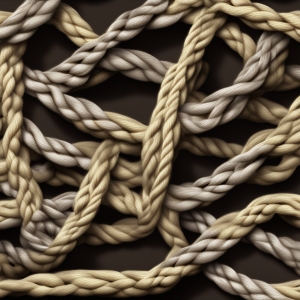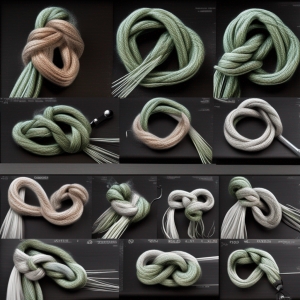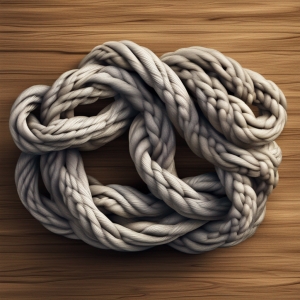Table of Contents:
Introduction to Knot Theory for Beginners: Importance and Benefits
Angling is more than just casting a line and waiting for a catch. It involves a plethora of skills and knowledge, and one of these is understanding knot theory. Knots are integral to the fishing process. They connect your line to your hook, your hook to your bait, and even your line to your reel. Familiarity with knots improves the strength, reliability and versatility of your fishing setup. Thus, learning and mastering the most important fishing knots is a powerful addition to any angler's arsenal.
Using the right knot can result in a significant difference between securing a great catch, and watching it swim away due to a knot failure. As a beginner, this knowledge will not only boost your confidence, but also enhance your efficiency and effectiveness when fishing. This article aims to guide you through some of the most important fishing knots, explaining them in simple and easy-to-understand steps. So, grab your fishing gear and let's dive in!
Understanding Basic Terms in Knot Theory
Before we delve into the specifics of different fishing knots, it is essential to understand certain basic terms in knot theory. These are words you'll frequently encounter when exploring different knots, whether in manuals or instructional videos.
Standing Line: This is the main line or the part of the line that is attached to the fishing reel. It's essential because it bears the most weight when you hook a fish.
Tag End: Also known as working end, it refers to the free end of the fishing line. This part is used to tie the actual knot.
Loop: This is simply a circle made by crossing the standing line over the tag end.
Bight: This is a section of line that is bent to form a U shape.
Turn: This involves wrapping the line around an object, such as another line or a hook. A single wrap constitutes one turn.
Now that we are conversant with the basic terms, we are ready to explore different types of fishing knots and how to tie them.
Overview: Essential Fishing Knots for Beginners
| Knot Type | Pros | Cons |
|---|---|---|
| Clinch Knot | Simple to tie, Strong | Can slip with some types of line |
| Palomar Knot | Very Strong, Easy to tie with practice | Difficult with thick lines |
| Uni Knot | Versatile, Can be used on most lines | Requires more practice to tie quickly |
| Blood Knot | Great for connecting two lines | Difficult to tie, Not for very different line sizes |
| Surgeon's Knot | Easy to tie, Good for joining two lines | Less streamlined, Can be weak on some lines |
Breaking Down Knot Theory: The Simplest Fishing Knots You Should Know

A fishing venture can either be incredibly fulfilling or extremely frustrating, depending heavily on the knots you use. As a beginner, you want to start with the most fundamental fishing knots that are both easy to master and highly reliable. Below we break down the knot theory into the simplest fishing knots that you should know.
The Clinch Knot: This is one of the most popular fishing knots. The Clinch knot offers a good balance of strength and simplicity. To make this knot, you need to pass the tag end through the eye of the hook and make about five turns around the standing line. Next, slip the tag end under the last turn, tightening the knot carefully, making sure it's neat and unyielding.
Palomar Knot: Known for its strength, the Palomar knot is also relatively easy to tie, making it a fantastic choice for beginners. Begin by folding the end of the line to create a double line. Then, pass the loop through the eye of the hook. After this, make a simple overhand knot with the loop. Slide the loop over the end of the hook and pull tightly.
Improved Clinch Knot: This knot is an amped-up version of the regular Clinch Knot. It's more complex, but its superior strength and reliability make the extra effort worth it. After following the steps to create a Clinch knot, you pass the tag end back through the last loop before tightening it.
Remember, knots are the weakest links in your fishing gear, hence the need to tie them well and to check them frequently. Each of these knots is suited to specific situations and knowing which one to use when can greatly improve your success and enjoyment on the water.
Benefits of Mastering the Right Fishing Knots
Striving to perfect your knowledge and skills at tying fishing knots has an array of associated benefits. When you can competently tie a variety of knots, a world of new opportunities opens that can significantly improve your chances of landing a successful catch, regardless of circumstances.
By mastering fishing knots, you unlock the ability to adapt to different fishing conditions. Different knots excel in varying scenarios including line type, thickness, or hook size. Having a repertoire of knots you can correctly tie will ensure that you're always equipped for success, be it in saltwater, freshwater, fly fishing, or deep-sea fishing.
On another note, the efficiency gained through knot mastery shouldn't be underestimated. Time spent frustratingly wrestling with your line or dealing with knot failures is time lost that could've been spent actually fishing. Your capacity to swiftly and surely tie sturdy knots can greatly increase your fishing output, enabling you to quickly respond to changing situations.
Cost effectiveness is another benefit of upping your knot game. Lines and leaders can get expensive, and losing tackle due to a poorly tied knot hurts. As you hone your knot tying skills, you'll suffer less tackle loss, saving you both money and time you’d have spent replacing lost equipment.
Finally, it’s about the very essence of angling, the thrill and satisfaction. There’s something fundamentally rewarding in mastering a complex skill and seeing it pay off directly in your catch. Despite the intricate nature of knot theory it's always worth the time and effort to learn. The sense of self-assuredness and pride makes the journey that much more fulfilling.
Steps to Tying the Most Important Fishing Knots

Mastering fishing knots means knowing how to tie them effectively. The importance of correctly tying a knot cannot be exaggerated as the knot is crucial for a successful day of fishing. Let’s go through the steps for tying three crucial beginner-friendly fishing knots.
Step-by-step guide to tying a Clinch Knot:
1. Pass the tag end through the eye of the hook.
2. Wrap the tag end around the standing line 5-7 times.
3. Insert the tag end through the loop near the eye of the hook.
4. Wet the knot with saliva or water to ensure it tensions smoothly and tighten.
Step-by-step guide to tying a Palomar Knot:
1. Fold the end of the line to create a double line and then pass the loop through the eye of the hook.
2. Tie a simple overhand knot with the loop, keeping the hook hanging loose.
3. Pass the loop below the hook.
4. Pull both ends of the line to tighten the knot.
Step-by-step guide to tying an Improved Clinch Knot:
1. Follow the same steps as when tying a standard Clinch Knot.
2. After inserting the tag end through the loop near the eye of the hook, pass it through the large loop that was just created.
3. Wet the line and pull on both the standing line and tag end to tighten the knot firmly against the eye of the hook.
It’s important to practice these knots regularly. Get comfortable with the process and look for opportunities to use these knots when you’re out in the field. Soon, tying these knots will feel like second nature.
Insider Tips for Perfecting Your Knot Tying Technique
Becoming proficient in tying fishing knots doesn't happen overnight, and it needs practice and patience. Here are some insider tips that can help accelerate your mastery of fishing knots.
Practice Frequently: Practice is the key to mastery in almost anything, including knot tying. Make it a habit to practice your knots regularly, even when you're not on an actual fishing trip.
Always Wet Your Lines: Before you pull a knot tight, it's important to wet the line with saliva or water. This reduces friction which could otherwise weaken the line, and it also makes the knot tighten more smoothly.
Don't Rush: Tying knots is a skill that requires dexterity and careful attention to detail. Don't hurry the process, especially when you're still learning.
Consider Using Tools: There are dedicated tools like knot tyers that can help beginners to learn faster and tie more consistent knots.
Understand the Knot's Purpose: Knowing when to use each knot is a significant part of mastering fishing knots. Less isn't always more: a simple knot may not serve you as well in certain situations as a more complex one.
Remember, the right knot when fishing could mean the difference between landing that big catch and it breaking free. By combining diligent practice with these insider tips, you’ll be well on your way to becoming an expert at knot theory.
Conclusion: Giving Fishing Knots the Respect They Deserve

There is a degree of artistry embedded in every knot tied, an alignment of the mind and fingers in orchestrated efforts to secure, bind, and hold. For the new angler, learning how to tie secure fishing knots can seem like a daunting task. Yet, as you've discovered, it's not as complex as it first appears.
Fishing knots are a crucial element in the angling mix, often overlooked, yet their role in linking us to the end reward is undeniable. Despite the size and power of our gear or the sophistication of our lures, it all falls apart if the knot fails.
The knots we've explored provide a solid foundation, but the world of knot theory extends far beyond our brief tour. As you continue on your fishing journey, don't hesitate to explore other knots and find the ones that suit your style and meet your needs. Remember, practice creates perfection, and with every knot tied, you strengthen not only your line but your angling skills as well.
Don't underestimate the power of a knot: Simple, yet powerful. Basic, yet sophisticated. A good knot won't just keep your line and hook together; it can be the difference between celebrating a great catch and recounting the story of the one that got away.
An Introductory Guide to Essential Fishing Knots
What are the 5 most important fishing knots?
The 5 most important fishing knots are the Clinch Knot, the Palomar Knot, the Uni Knot, the Loop Knot, and the Bimini Twist.
How do I tie a Clinch knot?
To tie a Clinch Knot, first pass the end of the line through the eye of the hook. Wrap it around the standing line 5-7 times, then pass the end back through the loop next to the eye, and back through the big loop. Pull it tight to secure.
What is a Palomar Knot used for?
A Palomar Knot is used for securing your fishing line to the hook. It's one of the strongest and most reliable fishing knots.
Why is the Uni Knot important?
The Uni Knot is versatile. It can be used for attaching the hook to the line, for joining two lines, and for attaching the line to the reel. It's a knot that's strong and easy to tie, making it a favorite among many anglers.
What is the Bimini Twist used for?
The Bimini Twist is used to create a strong loop that can handle big game fish. It's a bit more complex to tie, but its strength makes it worth learning for fishermen who want to tackle bigger challenges.







